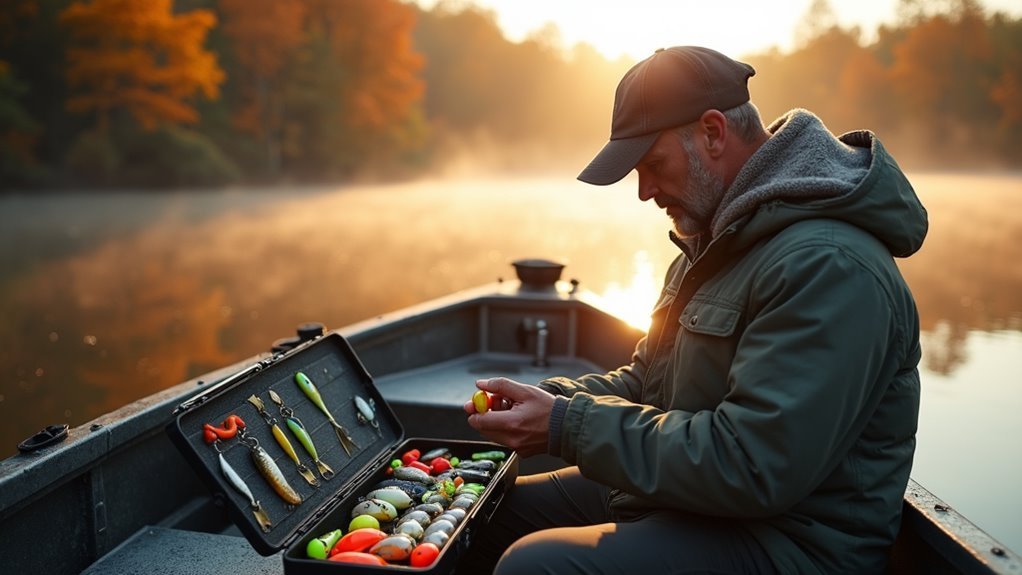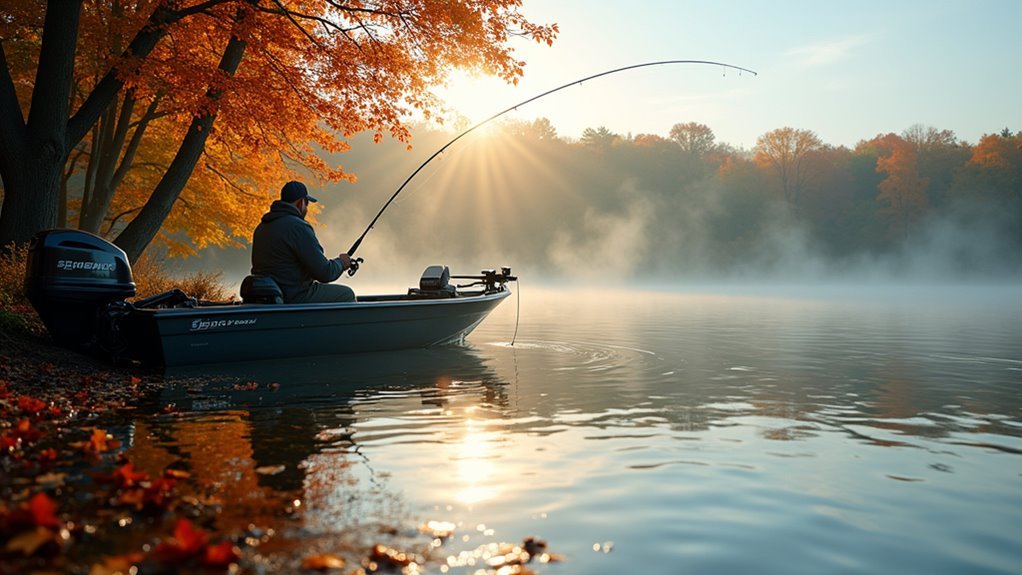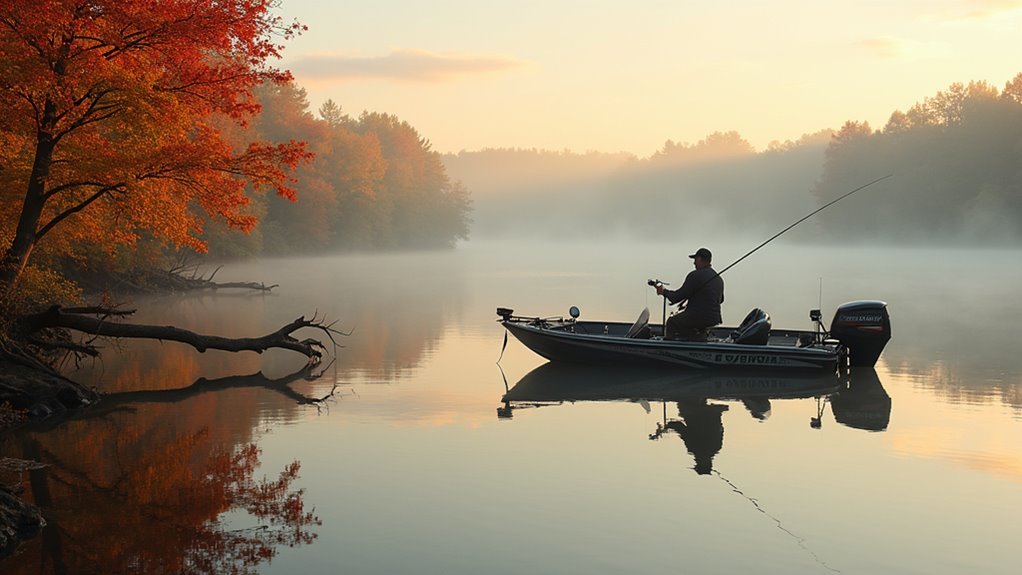To master fall bass fishing, we need to follow their migration from deep summer spots to shallower waters. As temperatures cool, bass chase baitfish along shorelines and creek channels to bulk up for winter. We’ll want to slow our presentations, downsize our lures, and adjust our colors to match changing conditions – subtle in clear water, brighter in stained water. Medium action rods with 12-15 pound fluorocarbon line will help us feel those sluggish bites. The rest of our journey reveals exactly where those trophy bass are hiding.
The Fall Bass Migration: Tracking Movement Patterns

When fall’s first crisp mornings start painting the shorelines with golden light, bass begin one of their most predictable yet misunderstood migrations of the year. We’ve noticed they follow baitfish from deep summer haunts to shallower waters as temperatures drop.
They’re hugging shorelines, coves, and creek channels, bulking up for winter. The metabolism of these fish slows considerably in cooler water, so we’ve learned to slow our presentations and downsize lures accordingly.
On cloudy days with low pressure, we’ve had our best luck. Those shallow areas warm faster, creating perfect feeding zones. We’ve landed some beauties by simply following their natural movement patterns.
Color Selection Strategies for Changing Fall Conditions

Why do bass seem so picky about lure colors when fall arrives? It’s all about matching their changing environment. We’ve found that early fall requires different colors than late fall as water conditions shift. On cloudy days, we stick with neutral, earthy tones that don’t spook cautious bass.
Clear water demands subtlety, while stained water calls for brighter colors that stand out. We always try to mimic local forage – shad patterns work wonders when baitfish are running. Last October, I switched from a chartreuse spinnerbait to a more natural bluegill pattern and immediately started catching fish. The bass were telling us exactly what they wanted! Understanding thrust requirements can also influence your lure selection and approach to fishing.
Slow and Steady: Adjusting Your Presentation in Cooling Waters

As temperatures drop, bass fishing demands a complete shift in technique and mindset. We’ve all been there – casting the same summer lures and wondering where the fish went. Bass metabolism slows considerably in cooler water, meaning they’re less likely to chase fast-moving baits.
We need to downsize our lures and slow our retrieves way down. Last October, I was struggling until I switched from power fishing to dragging a jig painfully slow along the bottom. The strikes weren’t aggressive – just subtle weight on the line – but they were consistent. Remember: patience pays dividends in fall fishing.
Deep vs. Shallow: Where to Find Bass Throughout Autumn

The location of bass changes dramatically throughout the fall season, creating a migration pattern that savvy anglers can exploit for consistent success. We’ve noticed bass follow a predictable path – starting in deeper waters early fall, then gradually moving shallow as temperatures drop.
In early autumn, focus on shifts between deep and shallow. By mid-fall, those creek channels and coves become hotspots as baitfish migrate inward. We once caught a five-pounder by simply following shad movements into a sheltered bay.
Perfecting Your Hook Set for Sluggish Fall Bites

Hook setting challenges intensify during fall as bass become increasingly sluggish with dropping water temperatures. We’ve all felt that frustration when a bite doesn’t translate to a catch!
To improve your odds, consider upsizing your hooks for better penetration. Soft plastics are our go-to this time of year—they provide that essential give when a bass strikes with less enthusiasm.
Treble-hooked lures like crankbaits can be lifesavers, giving you multiple chances to connect. We always pair these with medium action rods that balance sensitivity with natural movement.
Gear Recommendations for Late-Season Success
When temperatures drop and leaves start falling, your gear choices become critical for landing those fat pre-winter bass. We’ve learned the hard way that medium action rods offer the perfect balance between sensitivity and control for those slower fall presentations.
Don’t skimp on line – we recommend 12-15 pound fluorocarbon for its low visibility and superior hook-setting capabilities. Upsize your hooks for better success with sluggish biters, and stock your tackle box with larger jigs for deep water and soft plastics that give bass time to commit.
A quality fish finder becomes your best friend this time of year, helping locate those schools hugging structure and creek channels. Additionally, the integration of advanced navigation capabilities enhances your ability to position your boat precisely over the fish.
Frequently Asked Questions
How Does Moon Phase Affect Fall Bass Feeding Patterns?
We’ve noticed moon phases influence bass feeding in fall. During full moons, they often feed more at night and early morning. New moons typically trigger daytime feeding patterns as bass adapt to changing light conditions.
Can Bass Be Caught Effectively During Fall Rain Events?
Yes, we can catch bass effectively during fall rain. Rain lowers barometric pressure and washes food into the water. We’ll have better luck fishing near shorelines, coves, and creek channels during these events.
What Time of Day Yields Best Results for Fall Bass?
We’ll catch our best fall bass during early morning and late afternoon when light is low and bass are active. Midday can be productive too, especially on cloudy days with lower barometric pressure.
How Should I Modify My Approach for Pressured Fall Bass?
While many leave, we stay and adjust. For pressured fall bass, we’ll slow down our retrieves, downsize our lures, use more natural colors, and fish during off-peak hours when there’s less boat traffic.
Do Bass School Differently in Fall Than Other Seasons?
We’ll find bass schooling tighter in fall as they follow baitfish migrations. They’re more concentrated around shallow structures than in summer, gathering in predictable locations like creek mouths and coves during their feeding frenzy.
Conclusion
As the autumn leaves dance across the water, we’ve armed you with the expertise to land those trophy bass when others have stored their rods. We’ve weathered countless fall fishing seasons, learning these patterns the hard way so you don’t have to. Remember, fall fishing isn’t just about catching bass—it’s about experiencing the water’s transformation while everyone else is watching football. So grab your tackle and hit the water!